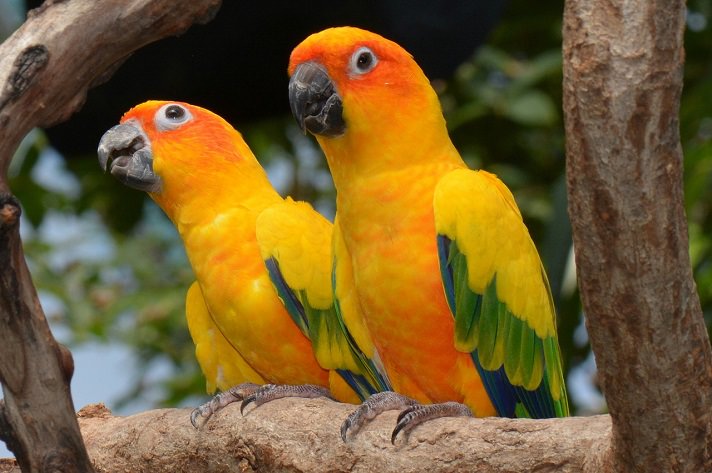The sun parakeet (Aratinga solstitialis), also known in aviculture as the sun conure, is one of the more popular conures of its size due to its stunning plumage, its extraordinary disposition, and its exceptional quality as a companion bird. They are lively, vocal, and expressive; this is a bird best known for its beauty and its big mouth.
They are medium-sized, vibrantly colored parrot that are native to northeastern South America (Guyana, Brazil). The adult male and female are similar in appearance, with predominantly golden-yellow plumage and orange-flushed underparts and face. The Sun parakeets are very social birds, typically living in flocks. They form monogamous pairs for reproduction, and nest in palm cavities in the tropics. These birds mainly feed on fruits, flowers, berries, blossoms, seeds, nuts, and insects. They are commonly bred and kept in aviculture and may live up to 30 years.
Description Of The Sun Parakeet
The Sun Parakeet is approximately 12 inches long, and is most recognizable by its bright orange and yellow coloring, often mottled here and there with splotches of green. They have black beak and white rings around their eyes, and a long, tapering tail. Though the coloration between the sexes is very similar, the males are said to be slightly brighter. Males are also said to have a squarer, flatter head and females a rounder, smaller head.
Habitat Of The Sun Parakeet
These Birds are native to South America, specifically Venezuela, Northern Brazil and Guyana. They usually inhabit fruiting trees and palm groves.
Diet Of The Sun Parakeet
The Sun Parakeet mainly feed on fruits, flowers, berries, blossoms, seeds, nuts, and insects, in the wild. They feed on both ripe and half-ripe seeds of both fruits and berries. They also consume red cactus fruit, Malpighia berries, and legume pods. At times, they forage from agricultural crops and may be considered pests. They require more protein intake during breeding season, more carbohydrates when rearing young, and more calcium during egg production.
In captivity, their diets may include grass seeds, beans, nuts, fruits (apples, papaya, blackberries, gooseberries, currant) etc, and vegetables (spinach, Chinese cabbage, cress, kale, broccoli, carrots, alfalfa, peas, endive, and sweet potatoes).
Behavior Of The Sun Parakeet
The sun parakeet is very social and typically occurs in large flocks of 20 to 30 individuals. They rarely leave the flock, but when they get separated from the group, they squawk and scream in a high-pitched voice which can carry for hundreds of yards, allowing individuals to communicate with their flock and return to them. The flocks are relatively quiet while feeding, but are known to be very vocal and make loud noises when in flight. They can travel many miles in a single day, and they are fast, direct flyers. Nonverbal communication is also practiced, with a variety of physical displays. Birds within a flock rest, feed one another, preen, and bathe throughout the daylight hours. They move through the trees using their beaks for extra support. They also have the ability to use their feet like hands to help hold, examine, or eat items. Sun Parakeets have been reported to nest in palm cavities. Sun Parakeet are extremely smart and curious, and so they require constant mental stimulation and social interaction. Their speech and ability to learn tricks in captivity are quite moderate.
Reproduction Of The Sun Parakeet
Young sun parakeets form monagamous pairs around 4 to 5 months of age. Prior to breeding, they may be seen feeding and grooming one another. Mating can last up to three minutes, after which pairs become very affectionate with each other. Prior to egg laying, the female’s abdomen noticeably swells. They have been known to nest in trees or in cavities of Maurita flexuosa palms. The fertility rate of sun parakeet is relatively high. A typical clutch size is three or four white eggs, and they may be laid in two- to three-day intervals. The females are responsible for the entire incubation period from 23 to 27 days, and only leave the nest for short feeding periods. The males aggressively protect the nest from potential predators. Eggs may fail to hatch if they are not kept warm or if the bird fails to break through the shell successfully, which may take from a few hours to a few days. Chicks are born blind, naked and completely vulnerable. Only after 10 days, they begin to open their eyes and their feather quills break through. Both parents participate in feeding the chicks. The young depend on their parents for 7 to 8 weeks after hatching, and only become independent after 9 to 12 weeks. These birds are sexually mature around 2 years of age and have a lifespan ranging from 25 to 30 years.
2 Interesting Facts About The Sun Parakeet
- Young sun parakeets are primarily green (resembling more of a jenday); their orange coloring becomes more pronounced as they mature.
- Sun parakeets are not sexually dimorphic; however, females are said to have slightly shorter tail feathers as well as rounder, slightly smaller heads.
Watch This: Sun Parakeet, Guyana (See around 16:15)
Sun Parakeet
These colorful birds are also known as Sun Conure. They are natives to Venezuela, Northern Brazil and Guyana. They consume a variety of fruits, flowers, vegetable and insects. These birds are lively, vocal, and expressive; best known for its beauty and its big mouth.
Article References:
- https://lafeber.com/pet-birds/species/sun-conure/
- http://www.planetofbirds.com/psittaciformes-psittacidae-sun-parakeet-aratinga-solstitialis
- https://en.wikipedia.org/wiki/Sun_parakeet
- https://howlingpixel.com/i-en/Sun_parakeet








1 Comment